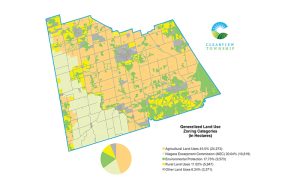Agricultural land uses make up for 45% of Clearview
Understanding the value of farmland is key to the future of farming, said Paul Maurice, the Ontario Federation of Agriculture (OFA) director representing farmers in Peel, Simcoe and York.
He said retention of farmland is a primary concern in Ontario.
“All of us need to understand that without farmland, if we expect to see the increases in population that we are looking for – we can plan for increased population, we can put up all these homes–butattheendofthedayif we can’t feed these people, we are no further ahead,” said Maurice.
He said while driving through the countryside the average person may think of farmland as an unlimited resource but in reality only about five per cent of all land in Ontario is available for agriculture.
“So it’s really important that we preserve every acre of farmland that we can,” said Maurice, who, with his wife Louise, raises broiler chickens and grows corn, soybeans, cereal grains and hay at their farm in Lafontaine.
Maurice said the only way to preserve farmland is through proper planning – by intensifying settlement areas and avoiding sprawl.
With agricultural land uses making up 45 per cent of Clearview Township’s land base, agriculture is identified as the municipality’s core business.
In total, there are 8,393 parcels in Clearview having a land area of over 137,524 acres. (Not including the 26,734 acres in the Niagara Escarpment Plan Area.)
Maurice said farmers are very good stewards of the land – their own and the land they rent – and take soil health very seriously because their livelihoods depend on it, and those of future generations of farmers.
According to Statistics Canada’s latest Census of Agriculture, the number of farms in Ontario reporting renewable energy production increased by 63.8 per cent to 8,483 in 2021. These farms accounted for 17.5 per cent of total farms in Ontario, the highest proportion in any province, and above the national rate (11.9 per cent).
In 2020, 67.2 per cent of farms in Ontario reported using land practices such as in-field winter grazing or feeding and rotational grazing, up from 60.1 per cent in 2015. This was also above the national rate (64.5 per cent). In particular, Ontario had the highest proportion (26.7 per cent) of farms planting winter cover crops when compared with other provinces.
A recent OFA survey found that in the coming year, farmers in southern and eastern Ontario believe that high input costs, high interest rates and the cost to service debt, and the growing tax burden on farms will pose the biggest challenges for their farm businesses.
Maurice said most farms in Canada, and especially in Ontario, are family owned and operated.
That can make the business of farming complex. Maurice said that’s because it’s a lifestyle and a business.
On average, Ontario farmers are at retirement age and many are thinking about succession planning.
“It’s a very tough subject,” said Maurice, of a conversation that is essential for setting up the next generation of farmers while allowing the parents a healthy transition into retirement.
He said most farms are being taken over by the next generation, but if for whatever reason, the children don’t take over the farm it will often be sold to a neighbouring farmer.
“We may end up having a few less farmers but the productivity is just as high,” said Maurice.
“If you don’t have it in your blood and in your heart to farm, you will not survive,” he said. “To be able to pass that on is difficult.”
As a fourth generation farmer, Maurice has been through it. He said the day his son said he wanted to farm was the best day of his life.
After 50 years of dairy farming and facing a number of challenges including labour shortages, they decided to transition to chickens. They now raise about 35,000 broiler chickens and have turned their acreage that supported the dairy operation into cash crops.
“That was one of the biggest and hardest decisions I’ve ever had to make, getting rid of the cows, because that was my life,” said Maurice.
“A lot of people don’t realize the economic impact that agriculture has on rural Ontario,” said Maurice.
There were 69,000 people employed in Ontario’s agriculture industry, comprising 0.9 per cent of Ontario’s total workforce in 2022.
One in 12 farm operators are under the age of 35 and 2021 marked the first increase in female-identifying farm operators in 30 years across the country. (Women make up 30.4 per cent of farm operators.)
There are lots of great opportunities in agriculture, said Maurice. People not born into a farm family may not be able to own their own farm but there are employment opportunities in the spin-off industries, including technology.
In addition to the farms themselves, there are a number of agricultural related businesses that provide essential services to farmers.
“We need to make sure that our kids, parents, the school system and elected officials understand the importance of agriculture and the opportunities that are out there,” said Maurice. “Food sustainability is really important and we, as a community, need to make sure we maintain that.”
Canadian farmers feed the world
As the fifth-largest agricultural exporter in the world (after the EU, U.S., Brazil, and China), Canada plays a significant role in feeding the world. In 2021, Canada exported more than $82 billion in agriculture and food products.
Canada is the world’s top producer of five commodities, producing more than 31 per cent of the world’s canola, 52 per cent of the world’s mustard, 40 per cent of the world’s flax, 39 per cent of the world’s pulses, and 70 per cent of the world’s maple products.
Ontario is home to 25 per cent of all the farms in Canada which produce more than 200 different commodities. It is an agricultural powerhouse, producing 54 per cent of Canada’s soybeans, 60 per cent of Canada’s grain corn, more than 60 per cent of the country’s greenhouse products and 40 per cent of Canada’s poultry and eggs and generating over $46 billion of economic activity for the province in 2021.
Farming is a family business
Contrary to popular belief, most farms in Canada are family businesses: 97 per cent of Canadian farms are family-owned, with about 25 per cent incorporated as family corporations.
The trend towards incorporation is more a result of adopting professional
Farmland in Ontario is disappearing
More than half of Canada’s highest quality farmland is in Ontario, but in the last decade Ontario has lost nearly 13 per cent of its farmland to non-agricultural land uses like urban development.
The 2021 Census of Agriculture reported that Ontario is losing 319 acres/day of farmland, significantly up from 175 acres/day in 2016. The loss of farmland poses a huge risk for local food production, food security, local economic development and jobs. The loss of farmland also has serious environmental and social implications. As agri-ecosystems, farms provide essential ecosystem services beyond food that are critical to the survival of people and other plants and animals. Moreover, farms contribute to the social cohesion, cultural identity and resiliency of rural communities.
Source: Niagara Agriculture Municipal Learning Network


